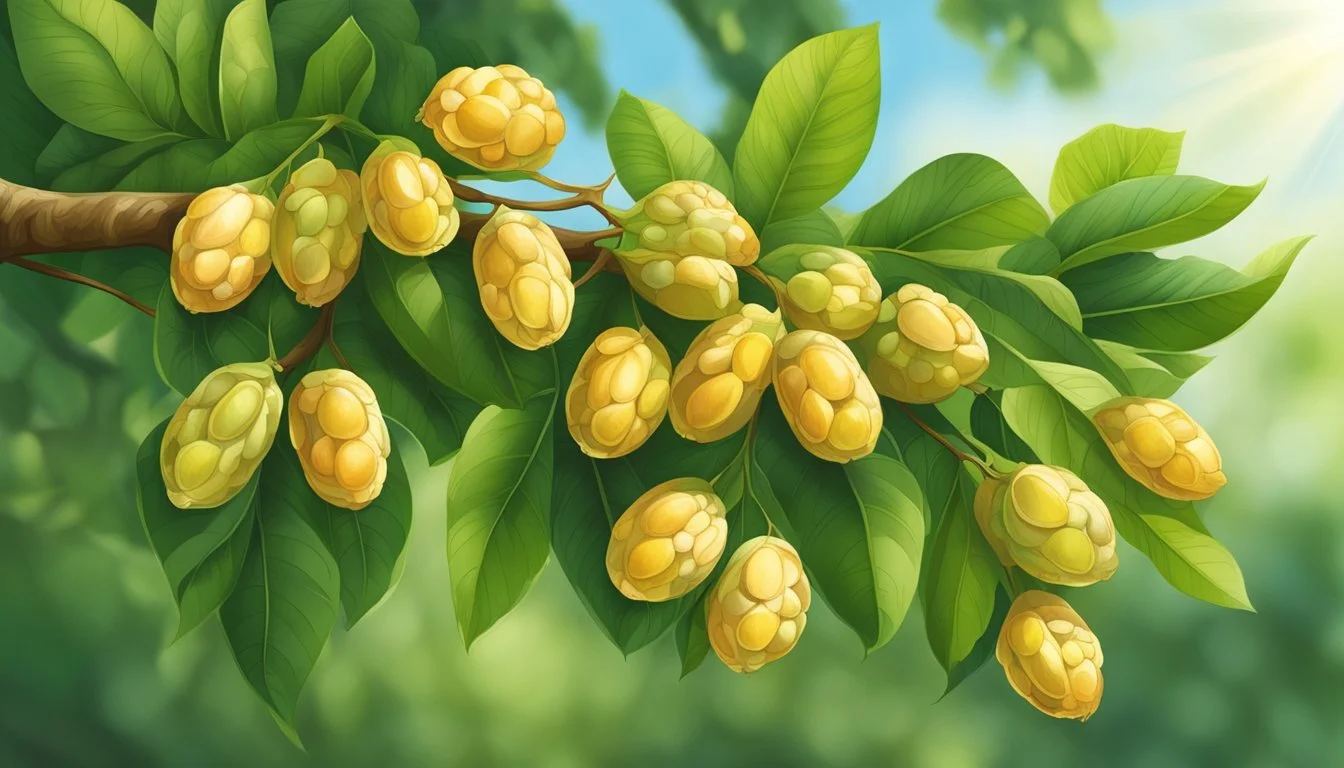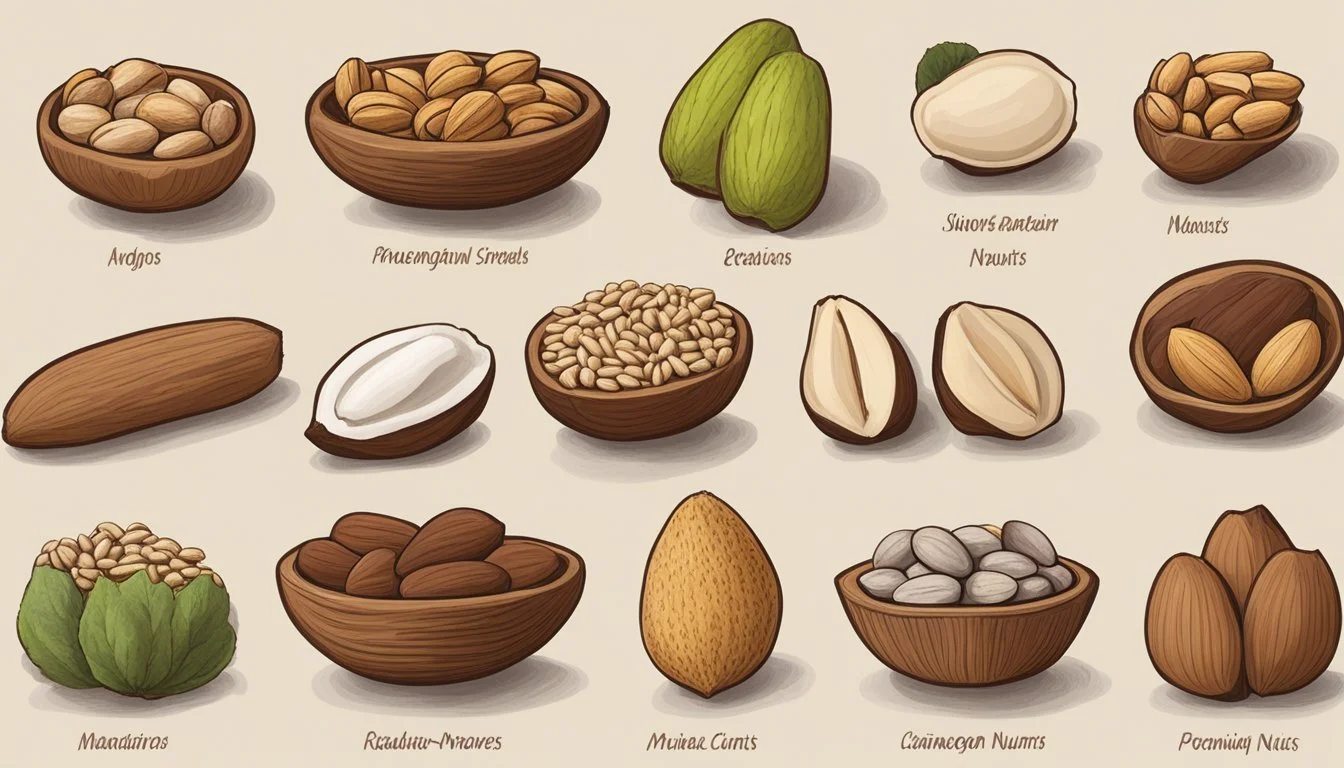Mongongo Nut Substitutes
Top Alternatives for Cooking and Snacking
The Mongongo nut, from the Schinziophyton rautanenii tree, is a staple in Southern Africa, revered not only for its nutrional benefits but also for its cultural significance. Commonly found among the wooded hills and sand dunes of the Kalahari, this nut is a linchpin in the diets of indigenous peoples, providing a rich source of protein, fat, and minerals. Its versatility allows it to be eaten raw, roasted, or processed into various traditional dishes.
Despite its importance in Southern Africa, the Mongongo nut is less familiar in other parts of the world, prompting a search for suitable substitutes. These substitutes must provide similar textural qualities and nutritional profile, which includes a unique blend of polyunsaturated fatty acids, monounsaturated fatty acids, and saturated fatty acids. The challenge lies in finding a nut that can match the Mongongo nut's distinctive taste and health benefits, making it a crucial ingredient for culinary and nutritive purposes alike.
Chefs and food enthusiasts looking to replicate the rich, nutty flavor of Mongongo nuts in their recipes might turn to more readily available nuts such as walnuts or pecans. While no substitute can perfectly mimic the unique characteristics of the Mongongo nut, these alternatives can offer a semblance in taste and nutritional value, thereby serving as a suitable stand-in for various culinary applications.
Botanical Profile of Mongongo
The Mongongo tree, known scientifically as Schinziophyton rautanenii, yields the nutrient-rich Mongongo nuts. Key characteristics of the tree and the description of the nuts themselves are distinctive and form an intrinsic part of the tree’s profile.
Mongongo Tree Characteristics
The Mongongo tree belongs to the family Euphorbiaceae and is the sole species in the genus Schinziophyton. An adult tree typically reaches a height of 15-20 meters. They are most commonly found on wooded hills and amidst sand dunes, thriving in Kalahari sand soil-types.
Leaves: The distinctive leaves are hand-shaped, lending a unique appearance to the foliage.
Wood: The wood is pale yellow, known for being lightweight yet strong.
Flowers: During the blooming season, one can observe the yellowish flowers.
Mongongo Nut Description
The nuts themselves are obtained from the fruits of the Mongongo tree. These nuts have a tough outer shell that encases the edible kernel.
Shape and Size: Mongongo nuts are oval and roughly the size of a small plum.
Nutrient Composition: Rich in nutrients, these nuts provide valuable food sources in their native regions.
Nutritional Value and Health Benefits
The Mongongo nut is notable for its dense nutritional content and its varied health benefits, primarily attributed to its rich composition of vitamins, minerals, and fatty acids.
Vitamins and Minerals
The Mongongo nut is packed with essential vitamins and minerals that are crucial for maintaining good health. One of the standout nutrients found in the Mongongo nut is vitamin E, a powerful antioxidant that supports skin health and immune function. Minerals such as zinc, calcium, magnesium, copper, and iron are present in considerable amounts, each offering its own set of health benefits, ranging from bone health to immune system support.
Zinc: Essential for immune function and healing.
Calcium: Key for healthy bones and teeth.
Magnesium: Involved in over 300 biochemical reactions in the body.
Copper: Important for red blood cell production.
Iron: Crucial for oxygen transport in the blood.
Fatty Acid Composition
Mongongo nuts are comprised of a beneficial mix of polyunsaturated fatty acids and saturated fatty acids. They are particularly high in linoleic acid, an omega-6 fatty acid that contributes to heart health and brain function. The presence of healthy fats in Mongongo nuts is essential for nutrient absorption and providing energy.
Polyunsaturated Fatty Acids: Include omega-3 and omega-6 acids which support heart health.
Saturated Fatty Acids: Though needed in lower quantities, play a role in various bodily functions.
Potential Health Impacts
Regular consumption of Mongongo nuts can have several potential health impacts due to their nutritional value. These impacts include the promotion of healthy brain function and the support of heart health. The protein content in Mongongo nuts aids in tissue repair and growth, while including this nutritious nut in one's diet can also contribute to balanced energy levels throughout the day.
Brain Function: Beneficial fatty acids support cognitive health.
Heart Health: Polyunsaturated fats can contribute to cardiovascular well-being.
Protein: Essential for muscle repair and enzyme function.
Culinary Uses of Mongongo Nuts
Mongongo nuts boast a wealth of culinary applications, from traditional African dishes to more modern, innovative recipes. These nuts are used in various forms including oil, roasted nuts, and paste, which are ingredients in both savory and sweet dishes.
Traditional Preparation Methods
Traditionally, mongongo nuts are consumed either dried or roasted, which enhances their flavor. In Southern Africa, they have been a staple food source, especially during the months when other food sources are scarce. Local methods of preparation include:
Roasting: Nuts are roasted over an open flame to bring out a rich, earthy taste.
Porridge: Dried mongongo nuts are ground into a meal and mixed with water to form a nutritious porridge.
Oil extraction: The oil from mongongo nuts, which is high in monounsaturated fats, is extracted and used for cooking.
Modern Culinary Applications
In modern cuisine, chefs have discovered innovative ways to incorporate mongongo nuts into a variety of dishes. Their unique flavor and nutritional profile provide a healthful alternative to more common nuts such as peanuts. These are some of the contemporary uses:
Paste: Similar to peanut butter, a paste made from blended mongongo nuts can be spread on toast or used as a dip for fruits and vegetables.
Cooking Oil: Mongongo oil is used for its high smoke point and nutrient content, ideal for sautéing and dressing salads.
Nut Meal: Ground mongongo nuts serve as a flour substitute, adding texture and flavor to baked goods and pastries.
Mongongo Nut Alternatives
When looking for alternatives to mongongo nuts, it is essential to consider nutritional profiles similar to that of the manketti nut. This includes a balance of monounsaturated and polyunsaturated fats, as well as fiber content. The following subsections detail specific nuts that can serve as substitutes both due to their nutritional makeup and their functionality in recipes.
Similar Nut Profiles
Nuts such as walnuts and pecans share a nutritional affinity with mongongo nuts, containing a healthful mix of polyunsaturated fats and monounsaturated fatty acids. These nuts are also a good source of fiber, which can contribute to improved cholesterol levels.
Walnuts: Rich in omega-3 fatty acids, similar to the high polyunsaturated fat content in mongongo nuts.
Pecans: Have a profile that includes monounsaturated fats, beneficial for maintaining healthy cholesterol levels.
Substitute Nuts in Recipes
In culinary applications, when manketti nuts are not available, several nuts can be used to mimic their texture and taste in recipes.
Substitute Nut Reason for Use Best Used In Walnuts Closely match the texture and oil content Baked goods, salads Pecans Provide a rich flavor and crunch Sauces, desserts Almonds Neutral flavor, readily available Snacking, garnishes
Walnuts and pecans can be dry-roasted and chopped to replicate the texture and crunch of mongongo nuts possibly the best. Almonds, while having a slightly different taste, can also be suitable substitutes, offering versatility in various dishes from garnishes to main components.
Economic and Cultural Importance
The Mongongo nut is not just a food source; it holds substantial economic and cultural weight in Southern Africa.
Regional Significance in Southern Africa
In countries like Namibia, Botswana, Zambia, and Zimbabwe, the Mongongo nut plays a crucial role in both local economies and diets. In these nations, especially in rural areas, communities rely on Mongongo nuts. They are a drought-resistant resource that provides essential nutrients. In times of scant resources, these nuts are a buffer against food insecurity. For instance, the San people, particularly the Ju/’hoansi in regions of Botswana and Namibia, depend on these nuts as a staple food source.
Cultural Practices and Symbolism
For many indigenous groups, such as the San people and the Tswana in Botswana, the Mongongo nut transcends its role as sustenance. It is deeply entrenched in their cultural identity and practices. In the lives of the Ju/’hoansi, the gathering and consumption of Mongongo nuts are part of a shared cultural heritage that has persisted for millennia. The nut stands as a symbol of resilience and survival, particularly in harsh desert environments like the Kalahari, where traditional food sources can be scarce.
Conservation and Sustainability
In the discussion of mongongo nuts, conservational practices interlock closely with their natural habitat, while sustainability measures ensure these practices support both the environment and local communities.
Habitat and Growth Conditions
The mongongo tree, indigenous to Southern Africa, primarily thrives in the Kalahari sand soil, a condition characteristically dry, yet able to support this resilient species. It is adapted to the wild environment of the Kalahari Desert, requiring minimal water, and benefiting from the nutrients provided by elephant dung and other organic matter. Wild animals also play a role, often aiding in the dispersal of mongongo fruit.
Conservation Efforts
Conservation efforts for the mongongo tree emphasize sustainable harvesting and land management. Due to its location in the arid Kalahari, where soil-types are less conducive to intensive agriculture, the trees are usually left to grow in the wild. Local communities have traditionally practiced conservation tillage, leaving a positive impact on the soil and biodiversity. Furthermore, the tree's hardiness contributes to carbon sequestration, a natural process crucial for offsetting carbon emissions.
Non-Food Uses
Beyond their nutritional value, mongongo nuts and various parts of the mongongo tree are used for a range of non-food applications, particularly in cosmetics and artisanal crafts. The utilities span from daily body care to functional items in households and industries.
Cosmetic and Medicinal Applications
The mongongo nut yields an oil that is highly valued in cosmetic formulations. This oil is extracted from the nut's kernel and is rich in oleic and stearic acid, making it a nourishing addition to skin and hair care products.
Hair: Mongongo oil is used as a conditioner, it helps tame frizz and adds a healthy shine.
Skin: The oil's emollient properties make it a good choice for moisturizing and softening the skin.
Additionally, due to its nutritional content, mongongo oil is also tapped for possible medicinal applications, such as a body rub to nourish and protect the skin in harsh weather conditions.
Other Uses of Mongongo Tree
The mongongo tree (Schinziophyton rautanenii), a member of the family Euphorbiaceae and the monotypic genus Schinziophyton, has several non-food uses:
Fishing Floats: The tree's buoyant exocarp and light wood are sometimes converted into fishing floats.
Toys: Local communities, particularly in Malawi, fashion dried parts of the mongongo tree into toys for children.
Insulating Material: The wood's insulating properties make it suitable for manufacturing drawing boards and other items that require a degree of thermal or sound insulation.
Habitat: The large branches of the mongongo tree offer shelter and food to various wildlife such as the greater kudu (Tragelaphus strepsiceros), which is intrinsic to maintaining the ecological balance in regions where these trees are indigenous.
Traditional Uses: The Bushman and other local tribes have been known to use the mongongo nut oil as a cosmetic and medicinal compound, notably for its protective qualities against the harsh sun and wind.
Comparative Analysis of Nut Alternatives
Selecting nut substitutes for Mongongo nuts involves considering factors like taste, texture, and availability. Consumers often look for alternatives that have similar nutritional profiles and culinary uses.
Taste and Texture Comparisons
When comparing nut alternatives, it's important to consider how closely they match the taste and texture of Mongongo nuts, which are known for their crunchy texture and a taste that is often described as a blend of almonds with a hint of piney flavor. Alternatives such as pumpkin seeds and sunflower seeds offer a similar crunch but with a distinctly different flavor profile. Seeds like sesame and hemp are smaller in size and might be softer in texture but are still used in a variety of recipes that require a nutty taste.
Availability and Accessibility
Mongongo nuts are indigenous to Southern Africa and may not be as readily available in other regions. Therefore, common and widely distributed alternatives such as sunflower seeds, pumpkin seeds, and sesame seeds can be considered for ease of access. In terms of accessibility, fruits that bear nut-like seeds, such as watermelon, can also provide an alternative. Nutrients found in Mongongo nuts like protein and fats are important considerations; for instance, pumpkin seeds offer high protein content, while sunflower seeds are rich in healthy fats. While some seeds and nuts may be available globally, regional availability can impact their practicality as substitutes, and animals like elephants that may consume these nuts in the wild are not affected by these human market fluctuations.









